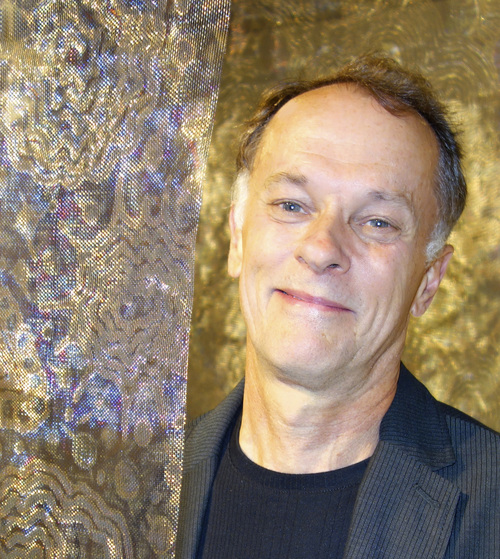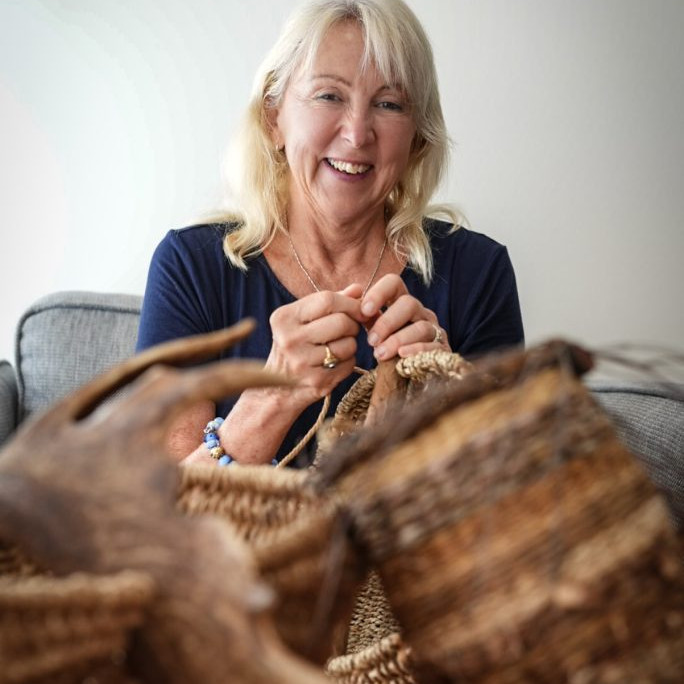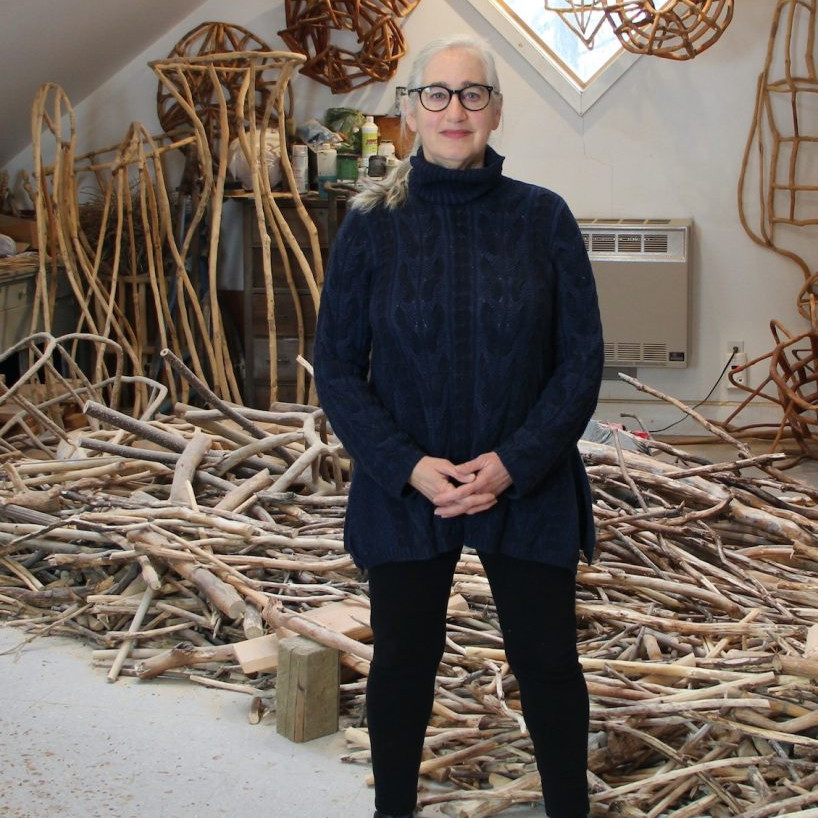Lanny Bergner Basket maker, Sculptor - Washington, USA.
When do you decide which of your work will be large pieces or installation pieces?
This varies depending on the exhibition venue. Sometimes I will do site-specific installations that are made for a particular space. At times I will do a series of small individual works, but given the opportunity I will turn them into an installation. This began long ago when I first started making suspended mesh works. I found that they could have a singular presence and they could also visually interact with one another. The Perelman installation is a good example of that.
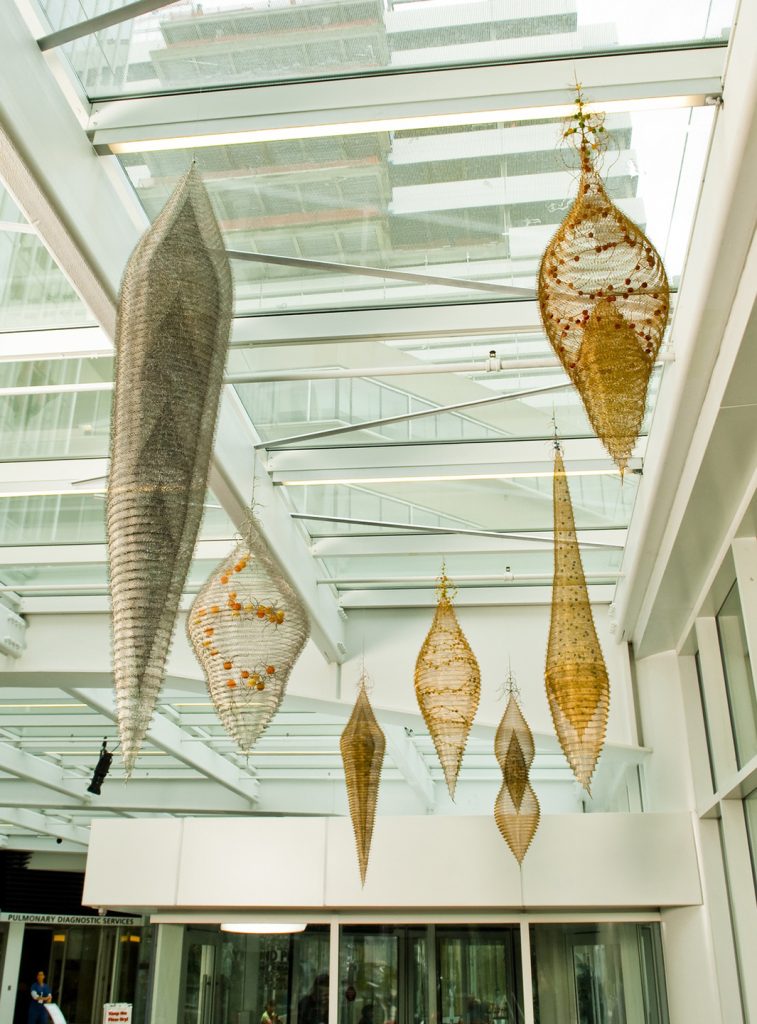
‘Perelman’ –Installation
Can you discuss the work and technique you used in your installation of suspended mesh at the Perelman Centre for advanced medicine?
The seven suspended pieces at the Perelman Centre were made as individual sculptures, but installed as an installation. The Perelman is a healthcare facility so the feeling I wanted the installation to invoke was one of healing and peacefulness.
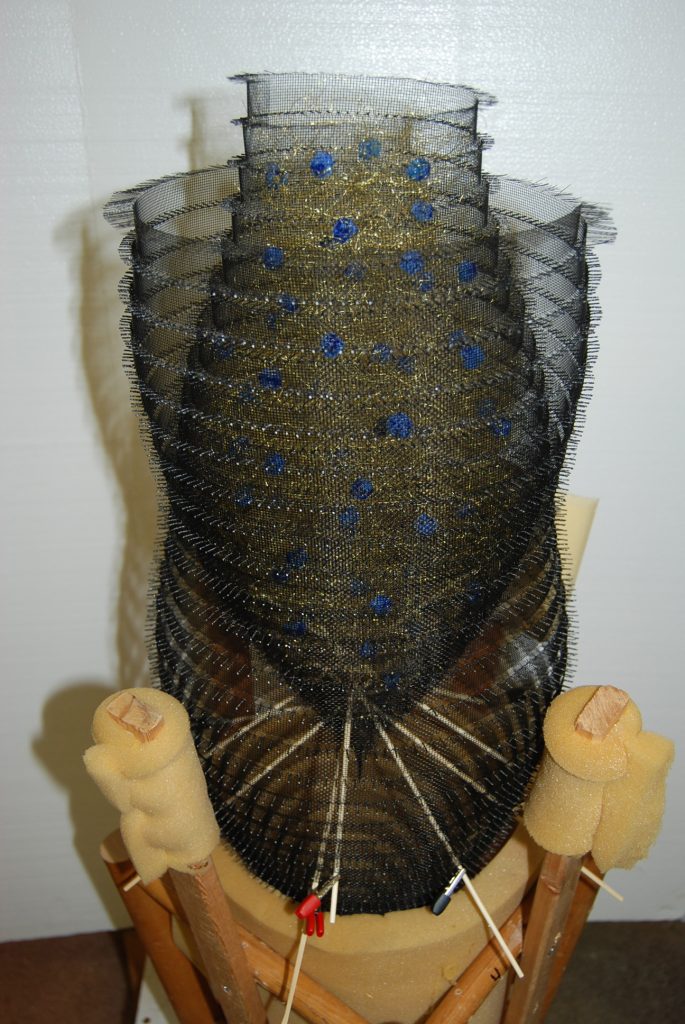
Twisting the frayed edges of long strips of aluminium, stainless steel and bronze mesh together with flat-nose pliers is how the pieces are made. They are all done in a spiral formation. Some of the pieces have loose frayed brass wire inside and/or vine-like stands of wire and tiny balls of glass frit and silicone. I exhibited some of the Perelman pieces before in an installation I did at SOFA Chicago (Sculptural Objects and Functional Art).
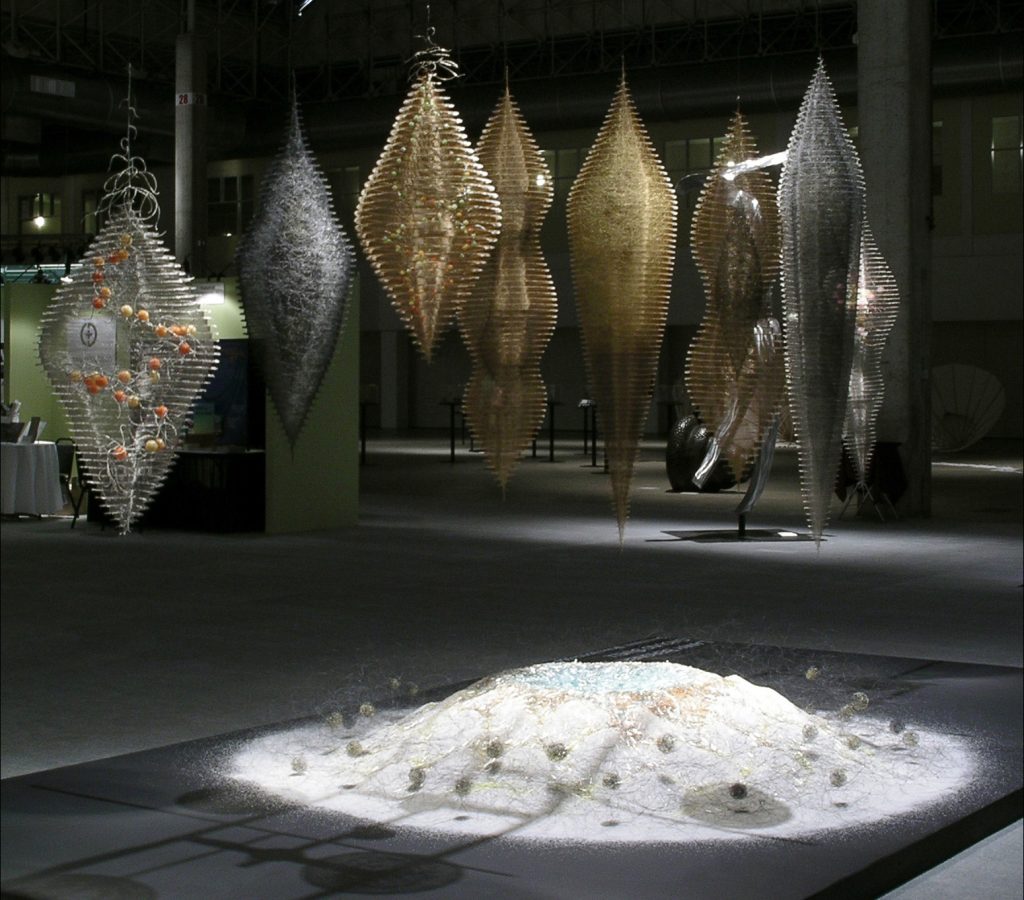
SOFA Chicago Installation: ‘Ground Swell’
You have work represented in Art in Embassies Program discuss the work and where it is?
“Primordial Vessel” is the piece being exhibited in the Art in Embassies Program. The painting/drawing on the mesh is created by flame-treating stainless steel mesh with a propane torch. It is being exhibited as part of a basketry exhibition at the US Ambassador’s residence in Tirana, Albania and will remain on view for the three-year term of the Ambassador’s appointment.
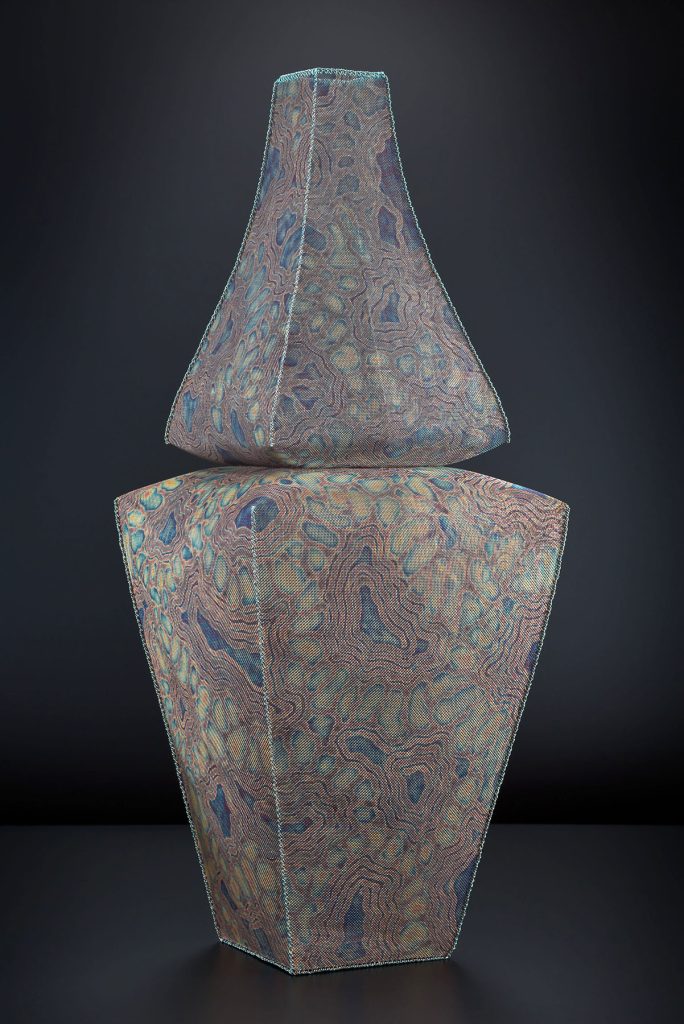
‘Primordial’
Can you expand on contemporary basketry and how it is being accepted in the current art world?
It is well accepted in the fibre art and craft world, but to a lesser extent by the “fine art” world. Basketry is pretty much a subgroup in the fibre arts, but it does have its own group of collectors and exhibition venues. There are overlaps of course and many times basketry is shown in broader fibre venues. Basketry has a long ancient tradition behind it and now artists and basket makers are using contemporary materials to create works. I came to the basketry arts by serendipity through sculpture (that is my formal university education) having received a BFA and MFA in sculpture. I believe this has given me a degree of freedom in my approach to basketry and art making. The basketry world has been embracing of artists who push out the boundaries of the medium and explore new approaches. There is much more cross fertilization going on in the art world today with contemporary artist using techniques and materials once confined to the fibre and basketry arts. This intermingling is healthy for all the arts.
Can you discuss the use of one district colour or colour group in your work?
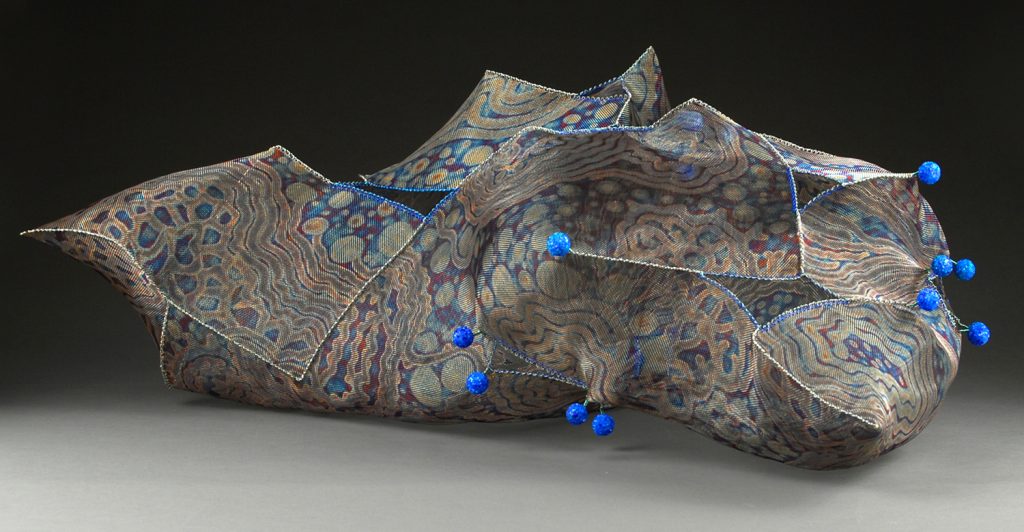
‘Ocean Deep’
Lets take “blue.” This happens to be one of my favourite colours and as it turns out, blue is one of the two main colours I can create while torch treating stainless steel mesh. The other is light to dark amber with the dark end almost a burgundy. So, these colours by default have become the main palette for the “flame painted” imagery on the mesh.
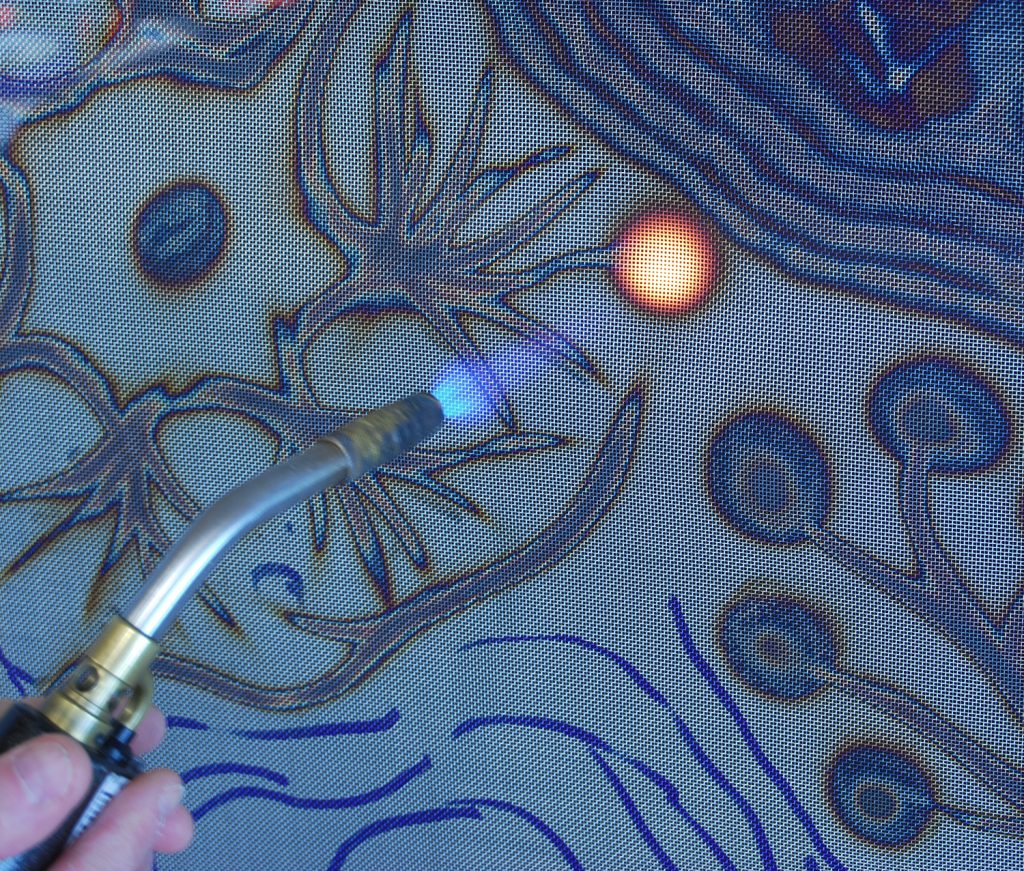
Flame painting
Explain the materials you use and how modern materials continue to fascinate and become part of your current work?
My primary material is metal mesh. I started out using common aluminium insect screening that I could buy at a hardware store. Now, I primarily work with stainless steel mesh. Stainless steel mesh is much more versatile for me because it comes in so many different gage and grid spacing types. This means I can work on a larger scale and create different types of forms depending on the mesh I selected.
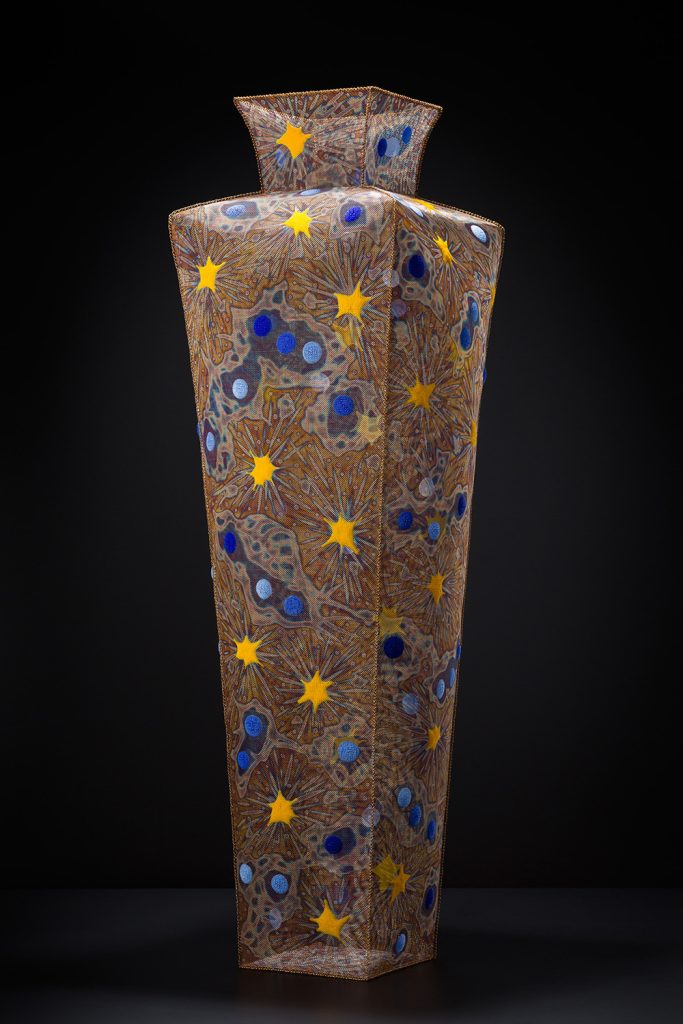
‘Celestial Vessel #8
I sort of accidentally come upon a material and then it gradually works its way into my artwork. That is what happened with silicone. I first used it as glue and then I began using it for visual effects. The most recent evolution of my use of silicone is mixing it with powdered pigment and then pressing it through the mesh and letting it dry. This has allowed me to add more colour to my work.
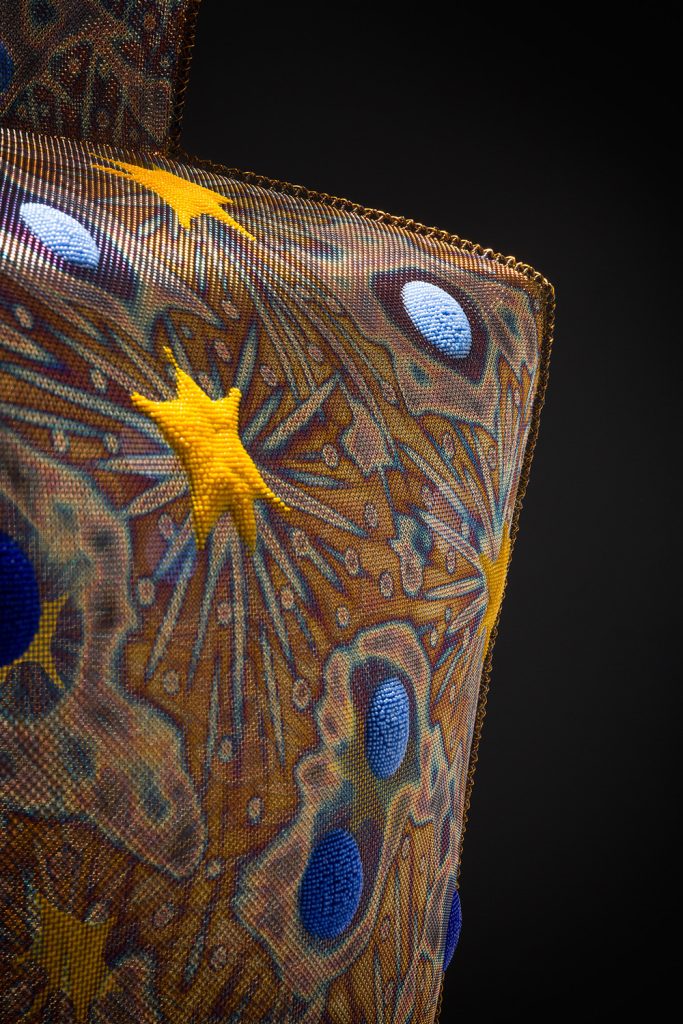
Detail of ‘Celestial Vessel #8
Explain how you work, where one piece is within another?
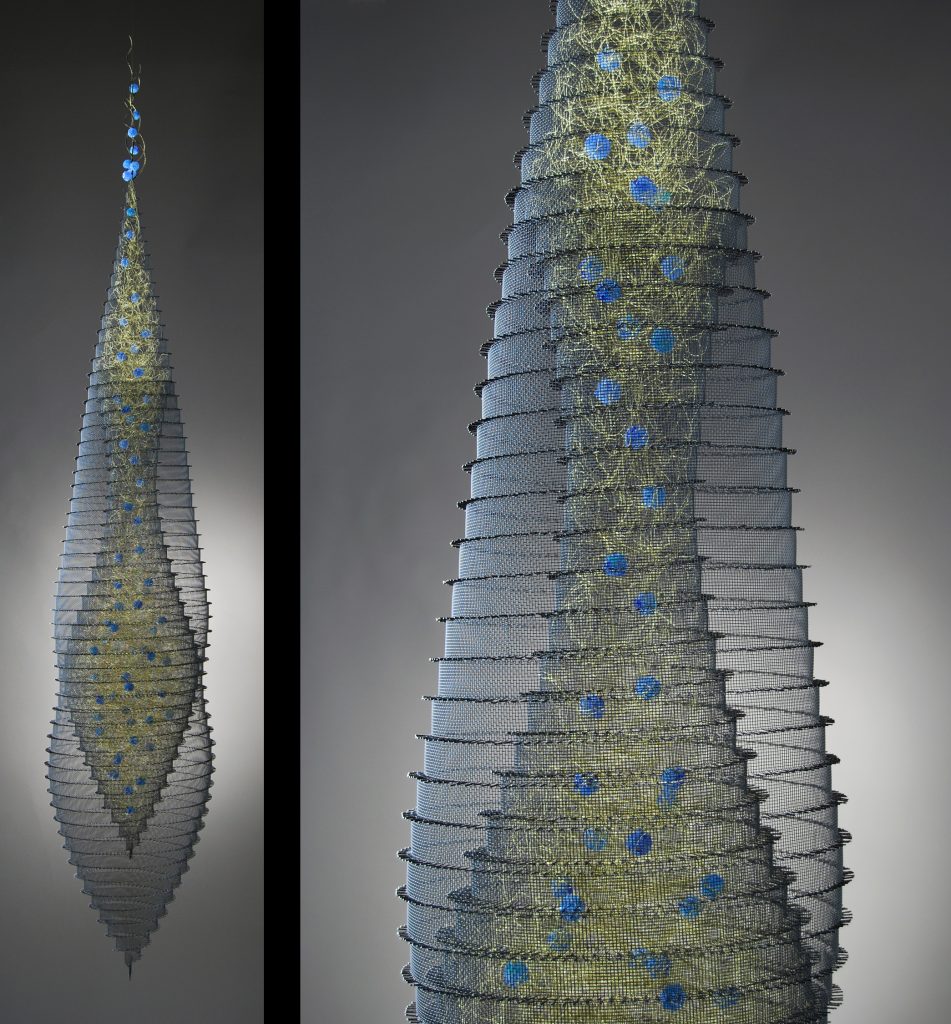
‘Blue Eliexer’
Several of my suspended “Pods” have interior elements. I first make the bottom half of the exterior casing. Then I make the lower portion of the interior form. When that form is high enough I attach it to the exterior casing. Then I bring the two forms up together and finally attach the two near the top of the piece. This is how “Blue Elixir” was made.
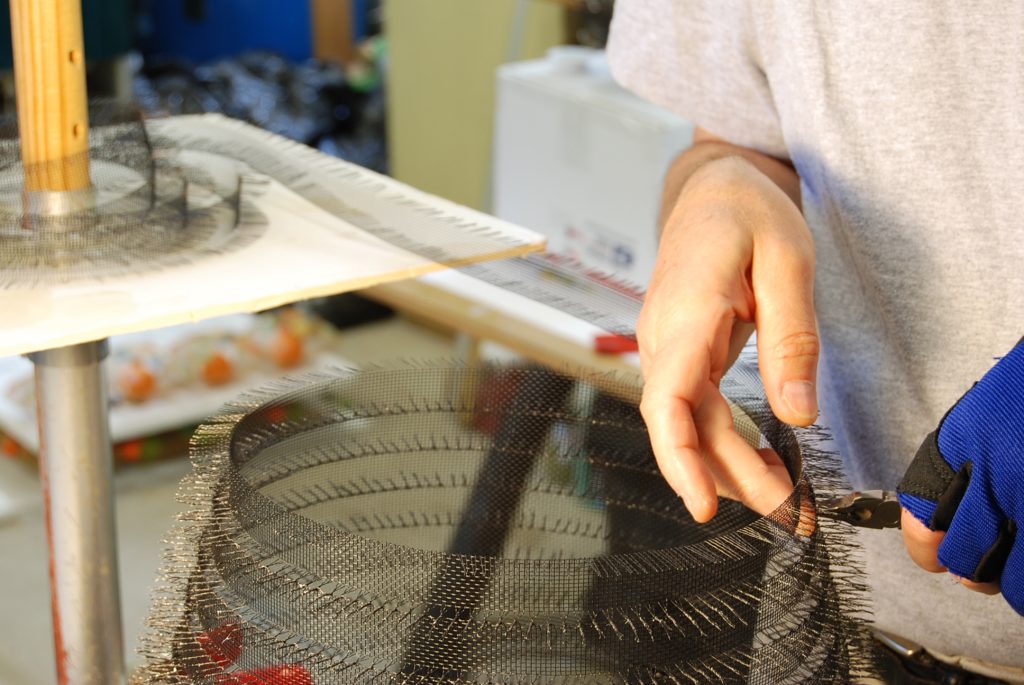
How important is lighting to the display of your work?
In some cases lighting can be very important. For installations I use lighting for dramatic effect and to bring out certain qualities of the mesh. In my “Primordial Muse” installation at the Whatcom Museum in Bellingham, Washington I worked with the exhibition designer to create a mysterious dimly lit display. We were able to highlight the shimmering blue light reflective quality of the mesh, making them appear almost like sheets of ice.
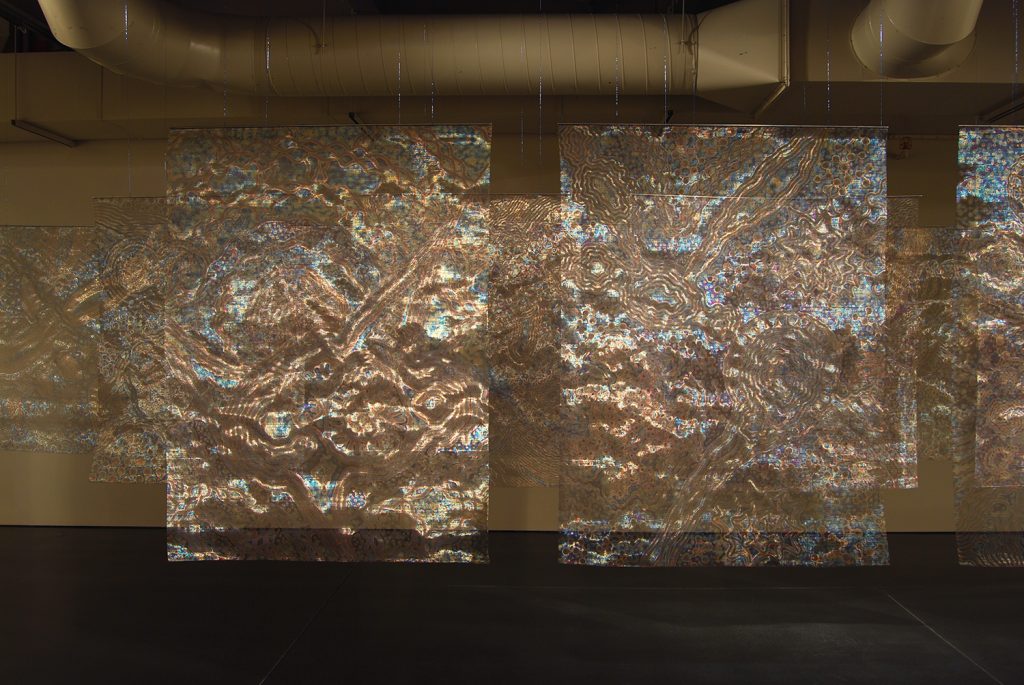
‘Primordial Muse’ –Whatcom Installation
Discuss your work ‘Life in the Universe’…
Inspiration?
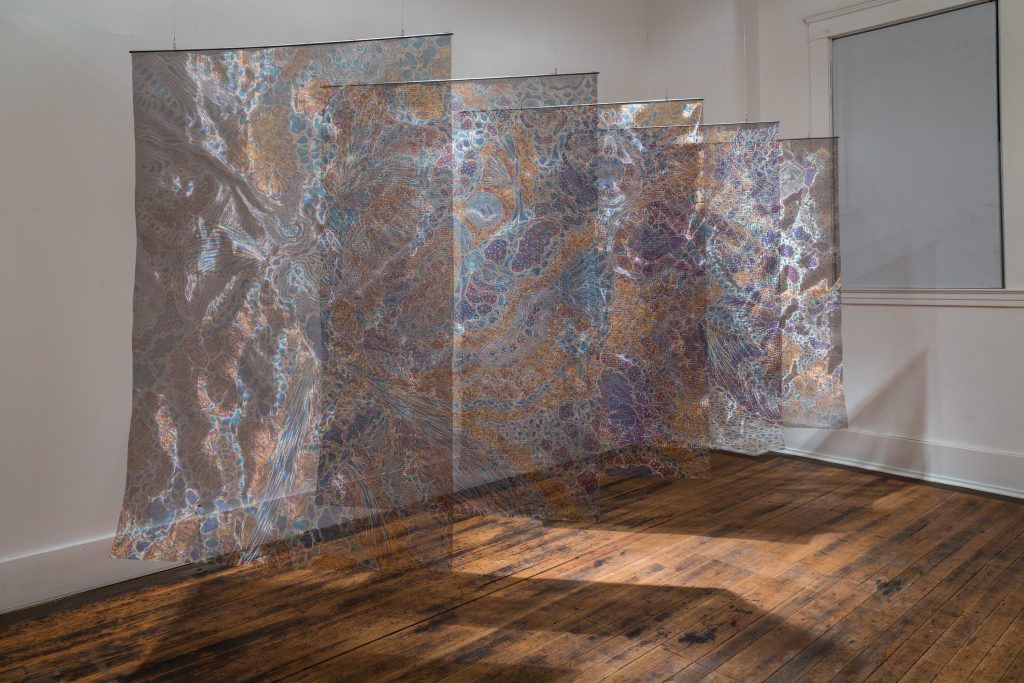
‘Life in the Universe’
The initial inspiration came from a book documenting the monographs of radiolarians by 19th century naturalist, Ernst Haeckel. The book “Art Forms from the Ocean” was a jumping off point for the imagery. The first body of work inspired by the book was the “Primordial Muse” screens. Further development of the imagery resulted in the larger “Life in the Universe” screens. These represent my musings on the infinite variety of life forms that must make up the universe. When I exhibit “Life in the Universe” or “Primordial Muse” I like to present them so the viewer can traverse the screens, as if they are being enveloped in the imagery. Colour? The colours range between grey, amber and blue. This is the range of colour I can achieve with direct torch burning on the mesh. How fast and close I run the flame over the mesh determine the colour and tone.
Technique?
The screens are torch treated using a propane torch. So, the flame is what creates the painting/drawing on the mesh. I did not do any preliminary drawing or use any templates to produce the imagery.
Size?
Each screen is 183 cm in height x 122 cm in width. I exhibited them with about a 50 cm space between the screens parallel to one another and set at a diagonal orientation to the wall. That way the screens partially overlap one another. Location? I exhibited them at the Anchor Art Space in Anacortes, WA and at Snyderman-Works Galleries in Philadelphia, PA. A single companion screen from the series is permanently installed at Emory Healthcare, St. Joseph’s Cardiology Clinic in Atlanta, GA.
How do you organize the hanging?
I let the room and lighting arrangement determine some of the parameters of the hanging. I’m not particularly interested in what particular order the screens are hung in.
Take three pieces of very different sizes and expand on them in relationship to size.
“Terra Un-firma” is a small piece made out of frayed charcoal aluminium mesh, various pins with coloured heads and some recycled ground plastic used for sandblasting. It fits in the palm of your hand and has a miniature asteroid-like appearance. The piece evokes a sense of intimacy, but at the same time gives the impression that you are gazing at a larger world through a distant lens.
“Celestial Vessel #7” is 154 mm tall; I wanted the form and scale of the piece to relate to the figure, with the vessel suggesting a human receptacle.
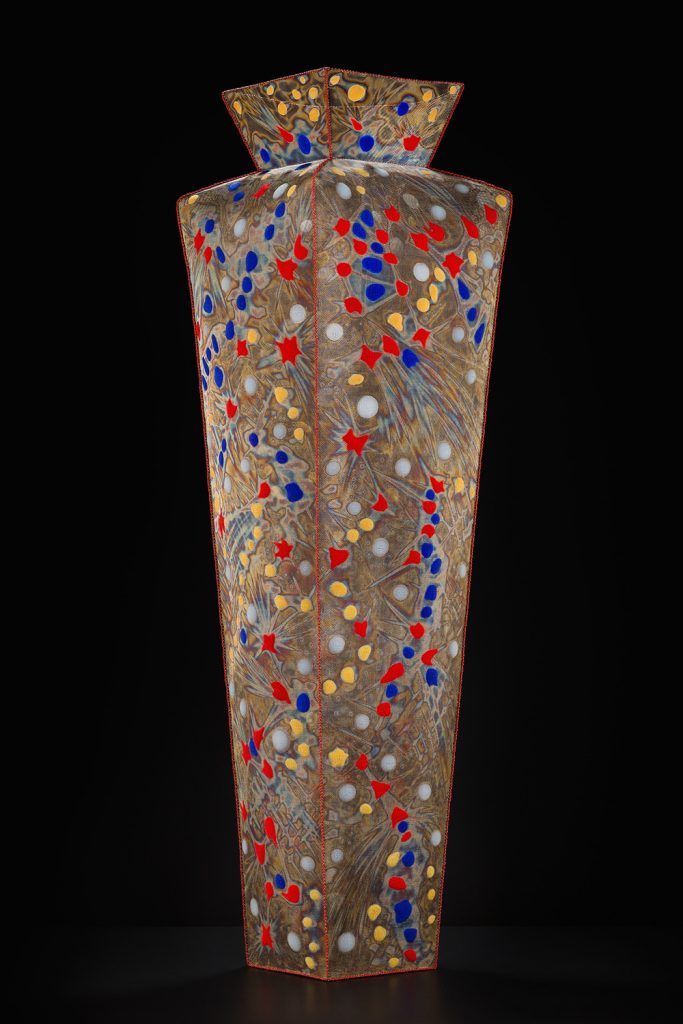
‘Celestial Vessel #7
“Above Earth Below Sky” is an installation I did for the 2007 Cheongju International Craft Biennale in Cheongju, Korea. The suspended black mesh piece is almost 2 ½ meters tall, so the scale is larger then human size. This too relates to the human form, but on a grander and more elevated scale.
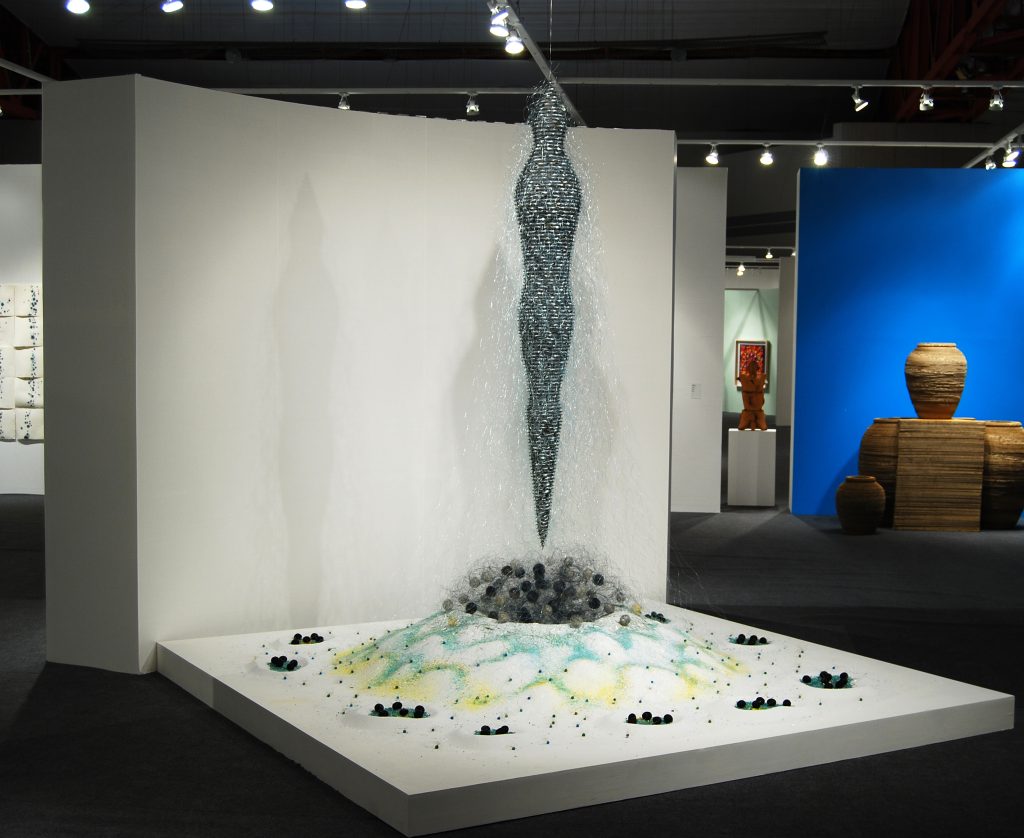
‘Above Earth Below Sky’
In 2016 you will be coming to Australia…
Explain how this invitation came about?
A workshop student of mine, Pamela MacGregor recommended me to Anne Kempton at Timeless Textiles in Newcastle. Pamela had recently come back from Australia giving her own workshop at Timeless Textiles and thought I would make a good fit for the program. Several months later Anne contacted me asking if I would like to have a show and conduct a workshop there.
Where and what will you be doing while ‘Down Under’?
The planning is still in the early stages, but I do know I will be spending time in Newcastle and hope to visit some other places in Australia, perhaps New Zealand as well. I wouldn’t mind finding an additional workshop venue “Down Under’, so something like that could help shape travel plans. There is a possibility my wife/artist, Eve Deisher, will also be exhibiting in Newcastle at the same time. If all goes well we both plan to make the journey and we hope to turn it into a business trip/vacation.
Where will people be able to see your work?
My exhibition at Timeless Textiles is scheduled for July 20 – August 14, 2016 and the workshop “The Art of Metal Mesh Working: Techniques and Process” will be held July 23-24. www.timelesstextiles.com.au
On a broader scale your work is in many public places can you discuss two pieces that are accessible to the public and why being there has given you such pleasure?
“Forest Sky” was a commission I did at the library in my hometown of Anacortes, WA. The library was built on the site where the old hospital used to be, which is where I was born. It’s even possible that “Forest Sky” is right above the location of my birth. I moved back to Anacortes in 1994 and I frequently visit the library and it is always a pleasure to see “Forest Sky” in the library’s entry lobby.
“Pattern Play” was a Washington State Arts Commission project I did at an elementary school in Snohomish, WA. The site is also a library. This is one of my favourite installations because of the enthusiasm of the school’s advisory committee and how they embraced the project. They even scheduled a daylong program where I met with each class to demonstrate how I made the installation and to answer their questions. I was exhausted by the end of the day, but it was a rewarding experience.
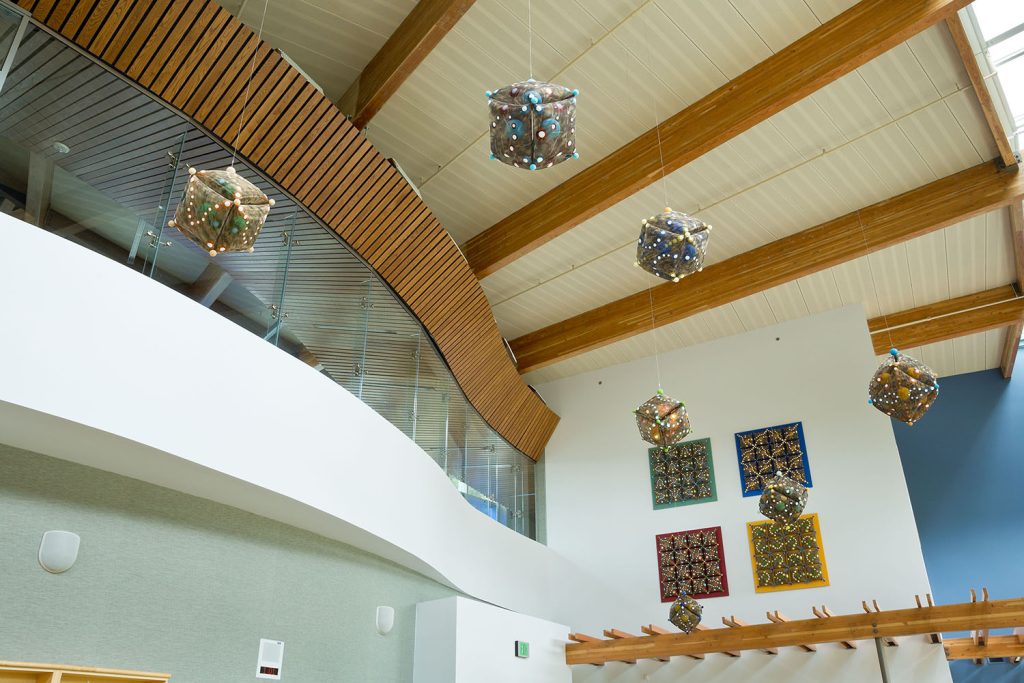
‘Pattern Play’
Can you give your thoughts on why Installations are becoming so well received by public galleries?
Installations are an exciting addition to a progressive exhibition program and they can transform a space into something wondrous. I believe this generates more interest in the gallery.
Contact details.
Lanny Bergner http://www.lannybergner.com/
email: lbergner@wavecable.com
Lanny Bergner, Washington, USA
Interview by Deborah Blakeley, April, 2015
Think a colleague or friend could benefit from this interview?
Knowledge is one of the biggest assets in any business. So why not forward this on to your friends and colleagues so they too can start taking advantage of the insightful information the artist has given?
Other artists you may be interested in:


